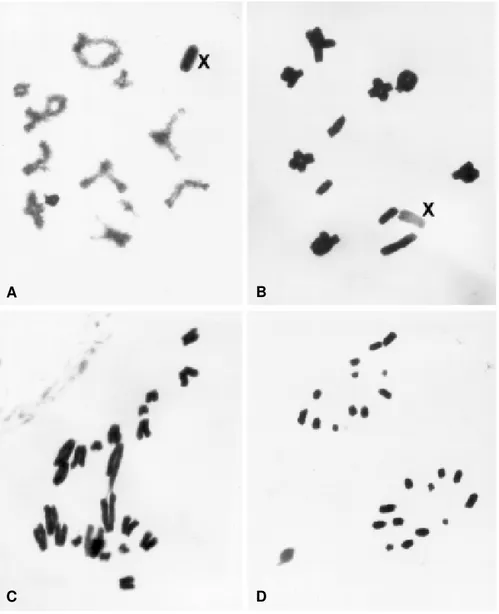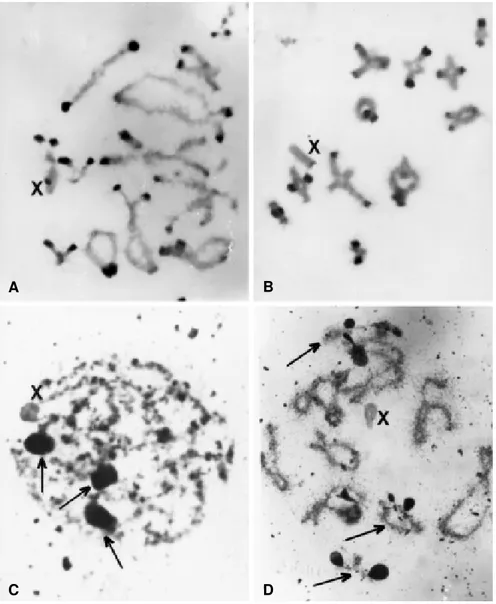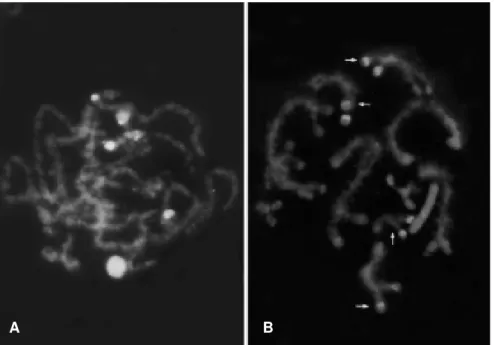INTRODUCTION
Although the family Acrididae has a worldwide dis-tribution, some subfamilies are exclusively neotropical, as is the case for Leptysminae (Carbonell, 1977). Belosa-cris is a genus of restricted occurrence, being found in Mexico, Paraguay, Brazil and Argentina. In Brazil, two spe-cies have been described: B. coccineipes, distributed from Pará to São Paulo and Mato Grosso, and B. stali, found in Mato Grosso and Goiás (Roberts, 1978).
There are few cytogenetic studies of the Leptysminae, most of them being limited to conventional analysis (Mesa et al., 1982; Colombo, 1989b). Mesa et al. (1982) made an extensive revision of the karyology of neotropical grass-hoppers in which 15 of the 17 species of Leptysminae ana-lyzed had karyotypes with 2n = 23/24 chromosomes, XO:XX sex determination and acrotelocentric chromo-somes. However, a karyotype of 2n = 21 was found in Stenopola pallida males, whereas Tetrataenia surinama had 2n = 19, with two pairs of metacentric and two of submetacentric chromosomes. Leptysma argentina pos-sesses a highly polymorphic karyotype, with centric fu-sions involving pairs 3 and 6. In this species, polymor-phism of the B chromosome and a complex of transloca-tions involving autosomes are particularly frequent (Bidau and Hasson, 1984; Colombo, 1989a, 1990).
The use of special techniques such as silver nitrate staining, for the identification of nucleolar organizer re-gions (NORs), and C-banding, for the detection of consti-tutive heterochromatin, allows for better karyotypic analy-sis. These techniques have been extensively used to
char-acterize several species of grasshoppers of the family Acrididae (King and John, 1980; Rufas et al., 1985). Differ-ent fluorochromes capable of detecting specific segmDiffer-ents of DNA base pairs have been used to analyze the composi-tion of heterochromatic segments with a homogeneous ap-pearance. DAPI (4’-6-diamidino-2-phenylindol) is specific for AT-rich regions, whereas CMA3 (chromomycin A3) is
specific for GC-rich regions (Schweizer, 1980).
In the present study, we examined the karyotype of Belosacris coccineipes, and identified the NORs and the C-banding pattern. The composition of the constitutive hetero-chromatin was also analyzed using the fluorochromes CMA3,
DAPI and acridine orange.
MATERIAL AND METHODS
Adult males and females of Belosacris coccineipes were collected from natural populations in the cities of Cabo and Recife, State of Pernambuco, Brazil. Fifteen specimens (11 males and 4 females) from the first popula-tion and five males from the second were analyzed. The cytological preparations were obtained from testes or ova-rioles. The latter were pretreated with colchicine (0.1%) for 6 h. The material was fixed in 3:1 ethanol-acetic acid. Slides were prepared by the classic squashing technique followed by staining with 2% lacto-acetic orcein for the conventional chromosomal analysis.
C-banding was done as described by Sumner (1972). The material was treated with 0.2 N HCl, 5% barium hydrox-ide and 2 x SSC. The temperature of the last two solutions was 60oC. Some slides pretreated for C-banding were also
Karyotype, constitutive heterochromatin and nucleolar organizer regions (NORs)
in
Belosacris coccineipes
(Acrididae-Leptysminae)
Vilma LoretoandMaria José de Souza
Abstract
Several techniques including C-banding, fluorochromes and silver staining were used to obtain information about heterochromatin pat-terns in the grasshopper B. coccineipes.Conventional staining showed a karyotype with 2n = 23 chromosomes in males and 2n = 24 in females, as well as XO:XX sex determination and acrotelocentric chromosomes. The medium-sized X chromosome was heteropycnotic positive at the beginning of prophase I and negative in metaphase I. C-banding revealed heterochromatic blocks in the pericentromeric regions of all chromosomes. Silver nitrate stainingin this speciesshowed three small bivalents (S9-S11) as nucleolar organizers with NORs located in the pericentromeric regions. CMA3-positive blocks were seen in pericentromeric regions of pairs M6, S9, S10 and S11. Sequen-tial staining with CMA3/AgNO3 revealed homology between the CMA3-positive bands and NORs of the bivalents S9, S10 and S11. The CMA3-positive block of the bivalent M6 could represent a latent secondary NOR. The results obtained permit us to distinguish two categories of the constitutive heterochromatin in B. coccineipes.
stained for 30 s with acridine orange (Bella et al., 1986). The silver nitrate staining was done by the method of Rufas et al. (1987), the slides being pretreated with 2 x SSC (60oC)
for 10 min and followed by staining with silver nitrate (1 g/ ml) at 70-80oC. For triple staining with CMA
3/DA/DAPI
(Schweizer et al., 1983), the slides were aged for three days and stained with CMA3 (0.5 mg/ml in McIlvaine buffer, pH
7.0, containing 10 nM MgCl2) for 60 min, washed with
dis-tilled water, stained with distamycin A (0.1 mg/ml) for 40 min, washed again and stained with DAPI (0.5 µg/ml) for 20 min. Sequential staining with CMA3/AgNO3 was also
used to characterize the NORs.
The slides were photographed with Agfa Copex Pan film. Fluorescence photomicrographs were taken with a Leitz Orthoplan microscope using Kodak T-MAX 400 film. Copies were made using Kodak Kodabrome Print F3 paper.
RESULTS
The karyotype of B. coccineipes, stained with lacto-acetic orcein, consisted of 11 autosomal pairs and a simple X chromosome in males (2n = 23, XO). The females had a karyotype of 2n = 24, XX. The autosomes were acrotelocentrics and could be arranged according to their size as large (L1-L2), medium (M3-M8) and small (S9-S11)
chromosomes. The X chromosome was of medium size, also acrotelocentric and had variable heteropycnotic be-havior during meiosis I. At the beginning of prophase I, the X chromosome was heteropycnotic positive and was more condensed than the autosomes. However, in meta-phase I this condition reversed and the X chromosome was heteropycnotic negative (Figure 1A-D).
C-banded preparations of B. coccineipes showed
Figure 1 - Conventional staining with lacto-acetic orcein of meiotic cells of Belosacris coccineipes. A) Diplotene, B) metaphase I, C) anaphase
I and D) anaphase II with 12 chromosomes. Note the X chromosome which is heteropycnotic positive in A and negative in B.
A B
positive staining in the pericentromeric regions of all chro-mosomes (Figure 2A,B). When acridine orange was used after C-banding, the chromosomes showed the same pat-tern seen with C-bands stained with Giemsa. Silver stain-ing was used to locate active NORs and three nucleolar remnants were identified in zygotene and pachytene cells. These remnants were located in pericentromeric regions of the small bivalent autosomes (S9-S11) (Figure 2C,D).
The triple stain CMA3/DA/DAPI revealed four CMA3
-positive blocks located in the pericentromeric regions of a medium-size chromosome (M6) and in three small ones (S9
-S11) (Figure 3A-B). This label was seen better in pachytene
cells. DAPI produced essentially homogeneous staining with no particular positive or negative blocks. Sequential stain-ing with CMA3/AgNO3 showed that the CMA3 positive
blocks in the small chromosomes (S9-S11) corresponded to
the NORs (data not shown).
DISCUSSION
According to Amedegnato (1974), the subfamily Leptysminae is represented in the neotropical regions by 22 genera. On the other hand, the Leptysmini tribe possesses eight genera (including Belosacris) and 42 species, about nine of them have been studied chromosomically.The fam-ily Acrididae has a very uniform karyotype with 2n = 23, XO and 2n = 24, XX. The subfamily Leptysminae (Mesa et al., 1982; Bidau and Hasson, 1984) is also characterized by this uniformity in chromosome complement.
The C-banding patterns in several species of grass-hoppers provide important clues on the changes that have occurred in the patterns of constitutive heterochromatin during the evolution of the group. King and John (1980) and Santos et al. (1983) observed numerous variations of the C-banding patterns of representatives of the Acrididae.
Figure 2 - A,B) Cells in diplotene showing the C-banding pattern of B. coccineipes. A) Initial diplotene and B) final diplotene. C,D) Nucleolar
organizer regions (NORs) stained with silver nitrate in meiotic chromosomes, C) zygotene and D) initial diplotene. The nucleolar remnants associated with the bivalents S9, S10 and S11 are indicated by arrows. X represents the X chromosome.
A B
Polymorphisms for extra segments (Camacho and Cabrero, 1982; Navas-Castillo et al., 1987) and B chromosomes (Henriques-Gil et al., 1984) are also frequent. The Leptys-minae Cylindrotettix obscurus, C. santaroseae and Lep-tysma argentina have B chromosomes and, in the latter species, C-banding shows heterochromatin blocks in the centromeric regions of all chromosomes and in the inter-stitial regions of three medium pairs (Bidau and Hasson, 1984). Although C-banding has been used in several spe-cies of Acrididae, only a few spespe-cies of thesubfamily Lep-tysminae(endemic to the neotropics)have been investi-gated with this approach. The C-banding pattern we ob-served in B. coccineipes was very uniform, with pericen-tromeric blocks in the entire chromosomal set.
Silver nitrate staining has been used to study nucle-olar activity and the distribution and position of NORs in different species of grasshoppers. Rufas et al. (1985) showed that the most common location of NORs was at proximal sites in medium and small chromosomes, dis-tributed in pairs throughout the genome of most of the species. However, in B. coccineipes, the NORs were re-stricted to autosomes, located in pericentromeric areas of the small chromosomes (S9-S11). Other species such as
Ramburiella hispanica, Chortippus apicalis (Rufas et al., 1985) and Xyleus angulatus (Souza et al., 1998) have NORs distributed both in the autosomes and in the sex chromosomes. In Radacridium mariajoseae (Rocha et al., 1997), the NOR is restricted to the X chromosome. On the other hand, Rufas et al. (1985) suggested that the presence of NORs in the X chromosome would be an ancestral con-dition for the family Acrididae. A similar situation has also been found in the Romaleidae (Rocha et al., 1997).
In B. coccineipes, the CMA3-positive blocks and the
homogeneous DAPI staining could mean the absence of AT-rich regions. In insects, especially grasshoppers, chromo-somal regions with differential fluorescence may be rich in GC base pairs. This pattern has been found in Chorthippus parallelus parallelus and C. p. erythropus (Bella et al., 1993), Podisma pedestris and P. ignatii (Bella et al., 1990) and Xyleus angulatus (Souza et al., 1998). However, in other species such as Arcyptera fusca, A. tornosi (Bella and Gosálvez, 1991) and Dociostaurus genei (Rodríguez-Iñigo et al., 1993), AT-rich regions have been identified. The affinity of CMA3 for chromosome regions that contain
rDNA in some organisms is attributable to the high GC con-tent of these regions (Schweizer et al., 1983). The use of CMA3 to identify rDNA regions has an advantage over
sil-ver staining in that CMA3 binds preferentially to GC-rich
DNA independent of whether it is active or not in the pre-ceding interphase.
Of the four CMA3-positive labels seen in B.
coccinei-pes, only three corresponded to NORs (pericentromeric regions of S9, S10 and S11) after silver staining, while in the
M6 chromosome no NOR was seen with silver nitrate.
Teixeira et al. (1997) showed that in Schistocerca pallens (Acrididae - Cyrtachantacridinae) small CMA3-positive
blocks were located at the interstitial position on L3 and
M6 and at a proximal position on M7 after triple staining
with CMA3/DA/DAPI. Silver staining confirmed the
ho-mology between CMA3-positive bands and the label in the
bivalents L3 and M6. The CMA3-positive label of the
biva-lent M7 could represent a latent secondary NOR. A similar
phenomenon can also explain the CMA3-positive label in
bivalent M6 of B. coccineipes. Other studies using in situ
A B
hybridization with rDNA probes could elucidate whether the CMA3-positive block in chromosome M6 is indeed a
latent secondary NOR that may be expressed, or whether it is a GC-rich region that bears no relationship with an NOR. In conclusion, we can distinguish two categories of constitutive heterochromatin in B. coccineipes: the con-stitutive heterochromatin positive for CMA3, restricted to
the NORs, and constitutive heterochromatin that has no specificity to AT or GC base pairs. This information could help elucidate the evolution of this type of chromatin within the Leptysminae.
ACKNOWLEDGMENTS
The authors thank Dr. Carlos Salvador Carbonell for the taxo-nomic identification of the specimens and Dr. Marcelo Guerra for reading the manuscript and for helpful suggestions. This research was supported by Fundação de Amparo à Ciência e Tecnologia do Estado de Pernambuco (FACEPE) and Conselho Nacional de Desenvolvimento Científico e Tecnológico (CNPq).
RESUMO
Algumas técnicas incluindo bandeamento C, fluorocromos e coloração com nitrato de prata foram utilizadas visando obter informações sobre os padrões de heterocromatina no gafanhoto
B. coccineipes.A análise convencional mostrou um cariótipo com 2n = 23 cromossomos nos machos e 2n = 24 nas fêmeas, sistema XO de determinação do sexo e cromossomos acro-telocêntricos. O cromossomo X de tamanho médio mostrou-se heteropicnótico positivo no início da prófase I e negativo em metáfase I. O bandeamento C revelou blocos positivos nas regiões pericentromé-ricas de todos os cromossomos. A coloração com nitrato de prata nesta espécie evidenciou 3 bivalentes pequenos (S9-S11) porta-dores de nucléolos com as NORs localizadas nas regiões pericentroméricas. Blocos CMA3-positivos foram visualizados nas regiões pericentroméricas dos pares M6, S9, S10 e S11. Pela coloração seqüencial CMA3/AgNO3 observamos homologia en-tre as bandas CMA3-positivas e as NORs dos bivalentes S9, S10 e S11. A marcação CMA3-positiva do bivalente M6 poderia repre-sentar uma NOR secundária latente. Os resultados obtidos permi-tiram distinguir duas categorias de heterocromatina constitutiva em B. coccineipes.
REFERENCES
Amedegnato, C. (1974). Les genres d’acridiens néotropicaux, leur classifica-tion par families, sous familles et tribus. Acrida 3: 193-204.
Bella, J.L. and Gosálvez, J. (1991). C-banding with specific fluorescent DNA-ligands: a new approach to constitutive heterochromatin heterogene-ity. Biotech. Histochem. 1: 44-52.
Bella, J.L., García de la Vega, C., López-Fernández, C. and Gosálvez, J. (1986). Changes in acridine orange binding and its use in the charac-terisation of heterochromatic regions. Heredity57: 79-83.
Bella, J.L., Gosálvez, J., Nichols, R.A., López-Fernández, C., García de la Vega, C. and Hewitt, G.M. (1990). Chromosome divergence in Podisma
Berthold through the Alps, Pyrenees and Sistema Ibérico. Bol. San.
Veg. Plagas (Fuera de serie) 20: 349-358.
Bella, J.L., Serrano, L., Hewitt, G.M. and Gosálvez, J. (1993). Heterochro-matin heterogeneity and rapid divergence of the sex chromosomes in
Chorthippus parallelus parallelus and C. p. erythropus (Orthoptera).
Genome36: 542-547.
Bidau, C.J. and Hasson, E.R. (1984). Population cytology of Leptysma argentina Bruner (Leptysminae, Acrididae). Genetica62: 161-175. Camacho, J.P.M. and Cabrero, J. (1982). Supernumerary segments in five
species of grasshoppers (Orthoptera: Acridoidea). Genetica59: 113-117.
Carbonell, C.S. (1977). Origin, evolution and distribution of the Neotropical Acridomorph fauna (Orthoptera): A preliminary hypothesis. Rev. Soc. Entomol. Argent.36: 153-175.
Colombo, P.C. (1989a). Chromosome polymorphisms affecting recombina-tion and exophenotypic traits in Leptysma argentina (Orthoptera): a populational survey. Heredity62: 289-299.
Colombo, P.C. (1989b). Effects of B-chromosomes on recombination in Cylin-drotettix obscurus (Leptysminae:Acrididae). Caryologia45: 65-79. Colombo, P.C. (1990). Effects of centric fusions on chiasma frequency and
position in Leptysma argentina (Acrididae: Orthoptera). II. Intra- and interchromosome effects. Caryologia43: 131-147.
Henriques-Gil, N., Santos, J.L. and Arana, P. (1984). Evolution of a complex B-chromosome polymorphism in the grasshopper Eyprepocnemis plorans. Chromosoma89: 290-293.
King, M. and John, B. (1980). Regularities and restrictions governing C-band variation in acridoid grasshoppers. Chromosoma76: 123-150. Mesa, A., Ferreira, A. and Carbonell, C.S. (1982). Cariologia de los
acridoideos neotropicales: estado actual de su conocimento y nuevas contribuciones. Ann. Soc. Entomol. Fr.18: 507-526.
Navas-Castillo, J., Cabrero, J. and Camacho, J.P.M. (1987). Chiasma redis-tribution in presence of supernumerary chromosome segments in grass-hoppers: dependence on the size of the extra segment. Heredity58: 409-412.
Roberts, H.R. (1978). A revision of the tribe Leptysmini except the genus
Cylindrotettix (Orthoptera: Acrididae: Leptysminae). Proc. Acad. Natl. Sci. Phila.129: 33-69.
Rocha, M.F., Souza, M.J. and Tashiro, T. (1997). Karyotype variability in the genus Radacridium (Orthoptera-Romaleidae). Cytologia62: 53-60. Rodríguez-Iñigo, E., Bella, J.L. and García de la Vega, C. (1993).
Hetero-chromatin differentiation between two species of the genus Docios-taurus (Orthoptera: Acrididae). Heredity70: 458-465.
Rufas, J.S., Esponda, P. and Gosálvez, J. (1985). NOR and nucleolus in the spermatogenesis of acridoid grasshoppers. Genetica66: 139-144. Rufas, J.S., Giménez-Ábian, J., Suja, J.A. and García de la Vega, C. (1987).
Chromosome organization in meiosis revealed by light microscope analy-sis of silver-stained “cores”. Genome29: 706-712.
Santos, J.L., Arana, P. and Giráldez, R. (1983). Chromosome C-banding patterns in Spanish Acridoidea. Genetica61: 65-74.
Schweizer, D. (1980). Simultaneous fluorescent staining of R bands and specific heterochromatic regions (DA-DAPI bands) in human chromo-somes. Cytogenet. Cell. Genet.27: 190-193.
Schweizer, D., Mendelak, M., White, M.J.D. and Contreras, N. (1983). Cy-togenetics of the parthenogenetic grasshopper Warramaba virgo and its bisexual relatives. X. Pattern of fluorescent banding. Chromosoma 88: 227-236.
Souza, M.J., Rufas, J.S. and Orellana, J. (1998). Constitutive heterochro-matin, NOR location and FISH in the grasshopper Xyleus angulatus
(Romaleidae). Caryologia51: 73-80.
Sumner, A.T. (1972). A simple technique for demonstrating centromeric het-erochromatin. Exp. Cell Res.75: 304-306.
Teixeira, L.V., Oliveira, P.R. and Souza, M.J. (1997). Coloração seqüencial CMA3/DA/DAPI e nitrato de prata em Schistocerca pallens (Acrididae-Cyrtacanthacridinae). In: Resumos do XIII Encontro de Genética do Nordeste, 23 a 26 de março, Maceió, AL, pp. 103.


